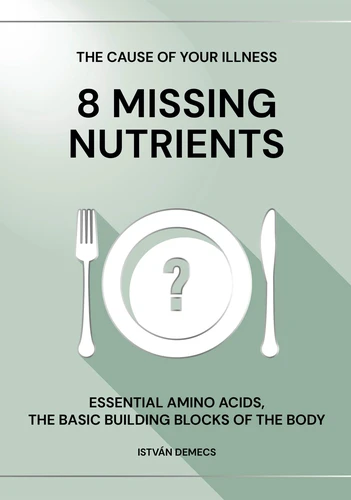THE CAUSE OF YOUR ILLNESS: 8 MISSING NUTRIENTS. ESSENTIAL AMINO ACIDS, THE BASIC BUILDING BLOCKS OF THE BODY
Par :Formats :
Disponible dans votre compte client Decitre ou Furet du Nord dès validation de votre commande. Le format Multi-format est :
- Pour les liseuses autres que Vivlio, vous devez utiliser le logiciel Adobe Digital Edition. Non compatible avec la lecture sur les liseuses Kindle, Remarkable et Sony
 , qui est-ce ?
, qui est-ce ?Notre partenaire de plateforme de lecture numérique où vous retrouverez l'ensemble de vos ebooks gratuitement
Pour en savoir plus sur nos ebooks, consultez notre aide en ligne ici
- Nombre de pages51
- FormatMulti-format
- ISBN978-615-6786-01-2
- EAN9786156786012
- Date de parution17/04/2024
- Protection num.NC
- Infos supplémentairesMulti-format incluant PDF avec W...
- ÉditeurVitaking
Résumé
I believe that essential amino acids will be the most important nutritional supplements in upcoming years. They will significantlyaffect the health of people and solve numerous chronic disease issues.
As the '90s saw an advance in the use of vitamins in medicine, so will essential amino acids be integrated into everyday life of people. The concept of orthomolecular medicine was first used by Linus Pauling (1901-1994), American Nobel-prize-winning chemist.
He realized that an optimal concentration of vitamins, minerals, and trace elements is required to achieve physical and mental well-be- ing. This is no different with amino acids; if possible, the statement is even more true. The results of their consumption, useless or magical, are dependent upon amounts and proportions. At the current technical standards of medicine, it is far easier to prove or refute a theory, than it was at the time of Linus Pauling, 40years ago.
Today there is a wide range of documented and peer-re- viewed research material, from molecular studies describing amino acids' mechanisms of action to clinical publications demonstrating their practical results. A concise summary of the latter is what I intended to write in this book.
He realized that an optimal concentration of vitamins, minerals, and trace elements is required to achieve physical and mental well-be- ing. This is no different with amino acids; if possible, the statement is even more true. The results of their consumption, useless or magical, are dependent upon amounts and proportions. At the current technical standards of medicine, it is far easier to prove or refute a theory, than it was at the time of Linus Pauling, 40years ago.
Today there is a wide range of documented and peer-re- viewed research material, from molecular studies describing amino acids' mechanisms of action to clinical publications demonstrating their practical results. A concise summary of the latter is what I intended to write in this book.
I believe that essential amino acids will be the most important nutritional supplements in upcoming years. They will significantlyaffect the health of people and solve numerous chronic disease issues.
As the '90s saw an advance in the use of vitamins in medicine, so will essential amino acids be integrated into everyday life of people. The concept of orthomolecular medicine was first used by Linus Pauling (1901-1994), American Nobel-prize-winning chemist.
He realized that an optimal concentration of vitamins, minerals, and trace elements is required to achieve physical and mental well-be- ing. This is no different with amino acids; if possible, the statement is even more true. The results of their consumption, useless or magical, are dependent upon amounts and proportions. At the current technical standards of medicine, it is far easier to prove or refute a theory, than it was at the time of Linus Pauling, 40years ago.
Today there is a wide range of documented and peer-re- viewed research material, from molecular studies describing amino acids' mechanisms of action to clinical publications demonstrating their practical results. A concise summary of the latter is what I intended to write in this book.
He realized that an optimal concentration of vitamins, minerals, and trace elements is required to achieve physical and mental well-be- ing. This is no different with amino acids; if possible, the statement is even more true. The results of their consumption, useless or magical, are dependent upon amounts and proportions. At the current technical standards of medicine, it is far easier to prove or refute a theory, than it was at the time of Linus Pauling, 40years ago.
Today there is a wide range of documented and peer-re- viewed research material, from molecular studies describing amino acids' mechanisms of action to clinical publications demonstrating their practical results. A concise summary of the latter is what I intended to write in this book.









